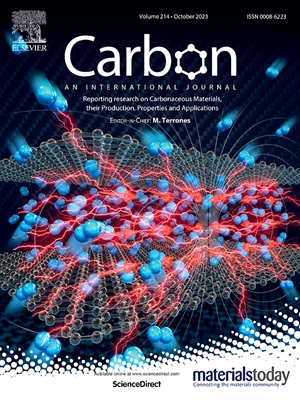In situ metal-catalyzed scale modulation to implement electromagnetic response for ultra-wideband microwave absorbers
IF 11.6
2区 材料科学
Q1 CHEMISTRY, PHYSICAL
引用次数: 0
Abstract
Carbon nanotubes (CNTs), as a typical one-dimensional nanomaterial, attract considerable attention in the field of microwave absorption due to their unique hollow structure and intrinsic conductivity properties. However, the unclear correlation between heteroatom modification/scale modulation of CNTs and their electromagnetic response mechanisms hinders the precise modulation of attenuation and impedance in CNTs-based microwave absorbers. In this work, we formulate a functional modulation strategy for CNTs based on the catalytic variations of diverse metal sources. A functionalized architecture featuring three-dimensional dielectric-magnetic coupling networks is constructed on carbon matrices through the in-situ catalytic growth of CNTs using Fe/Ni/Co metal catalysts. Through an activity regulation strategy for transition metal nanoparticles (NPs), we precisely tailor hierarchical CNTs morphologies, enabling controlled electromagnetic properties. Density functional theory calculations further reveal the unique cooperative electromagnetic nano-unit of the Co catalytic system, which endows the interface with efficient dynamic charge reconstruction, thereby realizing multi-band spatial polarization response. Additionally, the relatively ordered structure of hollow CNTs and magnetic Co NPs cleverly regulate the dielectric imbalances among the components. Benefiting from these comprehensive characteristics, the Co/CNTs/CM microspheres exhibit "ultra-broadband" absorption covering 8.2 GHz at a mere 2.0 mm, along with preeminent absorption capabilities at low frequencies across multiple thicknesses. The investigation reveals the foundational link between different metal catalysts and CNTs growth, providing valuable support for developing “ultra-broadband” microwave-absorbing materials.

超宽带微波吸收器的原位金属催化尺度调制实现电磁响应
碳纳米管(CNTs)作为一种典型的一维纳米材料,由于其独特的中空结构和固有的导电性,在微波吸收领域引起了广泛的关注。然而,碳纳米管的杂原子修饰/尺度调制与其电磁响应机制之间的不明确相关性阻碍了碳纳米管微波吸收器中衰减和阻抗的精确调制。在这项工作中,我们根据不同金属源的催化变化制定了碳纳米管的功能调制策略。采用Fe/Ni/Co金属催化剂原位催化生长碳纳米管,在碳基体上构建了具有三维介电-磁耦合网络的功能化结构。通过过渡金属纳米颗粒(NPs)的活性调节策略,我们精确地定制分层CNTs形态,实现控制电磁特性。密度泛函理论计算进一步揭示了Co催化体系独特的协同电磁纳米单元,赋予界面高效的动态电荷重构,从而实现多波段空间极化响应。此外,空心CNTs和磁性Co NPs的相对有序结构巧妙地调节了组分之间的介电不平衡。得益于这些综合特性,Co/CNTs/CM微球在2.0 mm处具有覆盖8.2 GHz的“超宽带”吸收,同时在多个厚度的低频处具有卓越的吸收能力。该研究揭示了不同金属催化剂与碳纳米管生长之间的基本联系,为开发“超宽带”微波吸收材料提供了有价值的支持。
本文章由计算机程序翻译,如有差异,请以英文原文为准。
求助全文
约1分钟内获得全文
求助全文
来源期刊

Carbon
工程技术-材料科学:综合
CiteScore
20.80
自引率
7.30%
发文量
0
审稿时长
23 days
期刊介绍:
The journal Carbon is an international multidisciplinary forum for communicating scientific advances in the field of carbon materials. It reports new findings related to the formation, structure, properties, behaviors, and technological applications of carbons. Carbons are a broad class of ordered or disordered solid phases composed primarily of elemental carbon, including but not limited to carbon black, carbon fibers and filaments, carbon nanotubes, diamond and diamond-like carbon, fullerenes, glassy carbon, graphite, graphene, graphene-oxide, porous carbons, pyrolytic carbon, and other sp2 and non-sp2 hybridized carbon systems. Carbon is the companion title to the open access journal Carbon Trends. Relevant application areas for carbon materials include biology and medicine, catalysis, electronic, optoelectronic, spintronic, high-frequency, and photonic devices, energy storage and conversion systems, environmental applications and water treatment, smart materials and systems, and structural and thermal applications.
 求助内容:
求助内容: 应助结果提醒方式:
应助结果提醒方式:


